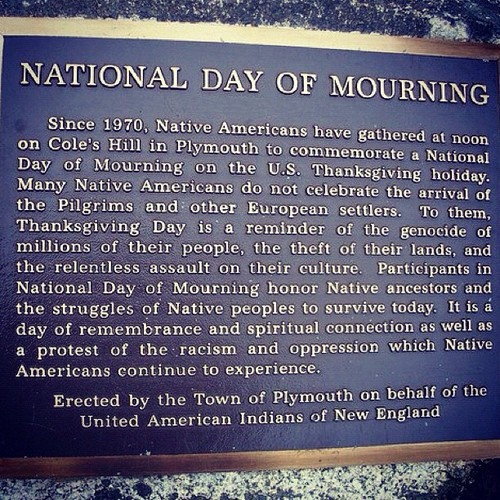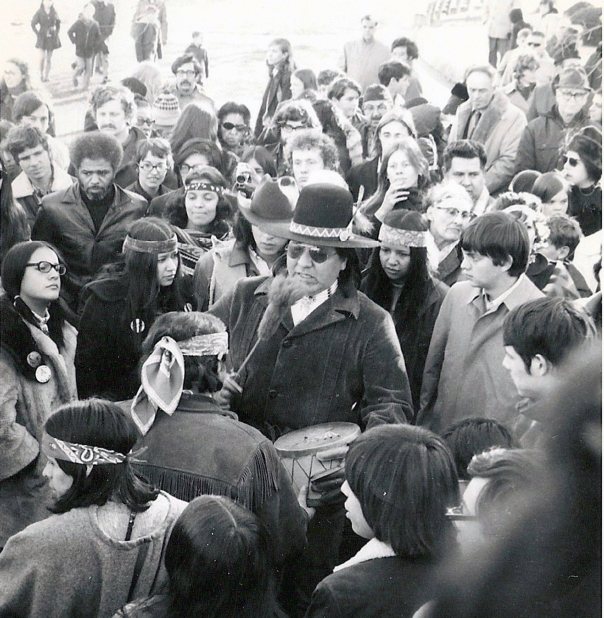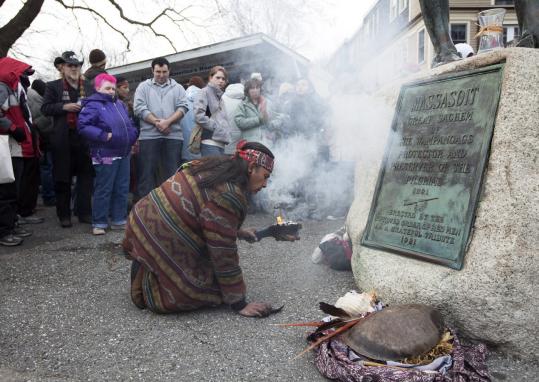A very difficult aspect of our history around the subject of Thanksgiving is that which involves wars, genocide and other horrors. How do we educate without condemning? How do we educate without bias? We cannot include the Wampanoag people or any other Native Americans without addressing these facts in our history. We hope the following lesson plan on the National Day of Mourning is of assistance to our much appreciated educators and parents.


These three photographs give a general idea about the National Day of Mourning and it's significance. It should be especially noted that eventually the town of Plymouth Massachusetts began to support the day. This is a very big step toward reconciliation.

This is a photograph of the plaque erected by the Town of Plymouth, Massachusetts on behalf of the United American Indians of New England to formally recognize the National Day of Mourning.

Photograph of a group of people at the first National Day of Mourning on November 26th, 1970.

Photograph of a prayer in front of the statue of Massasoit during the 41st National Day of Mourning in Plymouth, Massachusetts.

"Teaching Tolerance" is a wonderful website and we've chosen their publication titled "Thanksgiving Mourning" as an appropriate way to education our children about the meaning of Thanksgiving for Native peoples. The following is their lesson plan.
Thanksgiving Mourning
- Classroom Resources:
 Race and Ethnicity [1]
Race and Ethnicity [1]
- Anti-Bias Domain:
 Justice [2]
Justice [2]
- Grade Level:
 Grades 6 to 8 [3]
Grades 6 to 8 [3] Grades 9 to 12 [4]
Grades 9 to 12 [4]
- Subject:
 Social Studies [5]
Social Studies [5]
Overview:
In this activity, students will explore the perspectives of two Native American authors about the meaning of the Thanksgiving holiday and then write journal entries.
Framework
Much of the Thanksgiving story focuses on a peaceful, cross-cultural exchange between the "Pilgrims and Indians." While it's true that the Wampanoag and the Planters shared in a harvest celebration, within fifty years, the Wampanoag would no longer be a free people. For some Native Americans, Thanksgiving is no cause for celebration, but rather serves as a reminder of colonization's devastating impact on indigenous peoples.
In this activity, students will review two written works by Native American authors. The first -- a speech written by Wamsutta James in 1970 -- gave birth to the National Day of Mourning, which is observed on Thanksgiving by some indigenous people. To them, Thanksgiving is "a reminder of the genocide of millions of their people, the theft of their lands, and the relentless assault on their culture." The Day of Mourning, on the other hand, is a day of remembrance and spiritual connection, as well as a protest of the racism and oppression that Native Americans continue to experience.
The second document is an essay by Jacqueline Keeler, a member of the Dineh Nation and the Yankton Dakota Sioux; she works with the American Indian Child Resource Center in Oakland, Calif. Unlike some of her Native peers, Keeler celebrates Thanksgiving. And unlike most non-Native Americans, she does so through a distinctly indigenous lens.
Objectives
Activities will help students:
- Examine how diverse groups can perceive shared experiences differently
- Review commentary from indigenous writers about Thanksgiving
- Make inferences and draw conclusions based on written information
- Write letters of thanks
Essential Questions
- How and why do we celebrate Thanksgiving?
- What can we learn from diverse groups shared experiences?
- What is the story of Thanksgiving from a Native American perspective?
- What can we learn from the past and the present?
Materials
- Copies of
 The Suppressed Speech of Wamsutta James [6] from the United American Indians of New England
The Suppressed Speech of Wamsutta James [6] from the United American Indians of New England - Copies of
 Thanksgiving: A Native American View [7] by Jacqueline Keeler from the Pure Water Gazette (Editor's note: the song referenced on this webpage should be "America")
Thanksgiving: A Native American View [7] by Jacqueline Keeler from the Pure Water Gazette (Editor's note: the song referenced on this webpage should be "America")
Activities
1. Get together with a partner. While one of you describes what you know about the origin of the Thanksgiving holiday, the other one writes down key words and images from your description. (Note: If necessary, draw out elements of the origin story that relate to Native Americans.) Where did you learn these stories? What ideas or values do you think of when you celebrate Thanksgiving? (Note: Examples students may give: thanks, charity, generosity, being good neighbors.)
2. (Note: Share information from the Framework section and pass out copies of readings.) With your same partner, one of you read,  The Suppressed Speech of Wamsutta James [6], and the other reads,
The Suppressed Speech of Wamsutta James [6], and the other reads,  Thanksgiving: A Native American View [7]. After you finished reading, take turns summarizing what you read to each other.
Thanksgiving: A Native American View [7]. After you finished reading, take turns summarizing what you read to each other.
3. As a class, discuss:
- Reflect back on the values of Thanksgiving you described at the start of the activity. Did the Pilgrims uphold these values in their treatment toward the Indians? Why?
- What was new to you in the authors' descriptions of the first Thanksgiving? Why do you think these details are sometimes omitted from popular culture's take on Thanksgiving?
- Why does Keeler refer to Native Americans as a "very select group of survivors"? Is her characterization consistent with James's perception? Why?
- Wamsutta James' speech inspired some Native Americans to boycott Thanksgiving and instead observe a National Day of Mourning. Keeler takes a slightly different approach. Which approach makes the most sense to you? Why?
- Keeler sees present-day Thanksgiving celebrations as a tool for healing. What are ways this can happen? Does the Day of Mourning advance or hinder healing? Why?
- In what ways are James's and Keeler's perspectives gifts to our nation?
4. To wrap up, write journal entries about whether you have a new view of Thanksgiving. Identify specific things you learned from either James or Keeler and explain how this new knowledge affects your understanding of Thanksgiving.
 Standards [8]
Standards [8]
Activities and embedded assessments address the following standards ( McREL 4th edition [8])
McREL 4th edition [8])
Language Arts
Standard 1. Uses the general skills and strategies of the writing process.
Standard 3. Uses grammatical and mechanical conventions in written compositions.
Standard 8. Uses listening and speaking strategies for different purposes.
Working With Others
Standard 1. Contributes to the overall effort of a group.
Standard 3. Works well with diverse individuals and in diverse situations.
Standard 4. Displays effective interpersonal communication skills.
United States History
 Standard 1. [9] Understands the characteristics of societies in the Americas, Western Europe, and Western Africa that increasingly interacted after 1450
Standard 1. [9] Understands the characteristics of societies in the Americas, Western Europe, and Western Africa that increasingly interacted after 1450
 Standard 2. [10] Understands cultural and ecological interactions among previously unconnected people resulting from early European exploration and colonization
Standard 2. [10] Understands cultural and ecological interactions among previously unconnected people resulting from early European exploration and colonization
